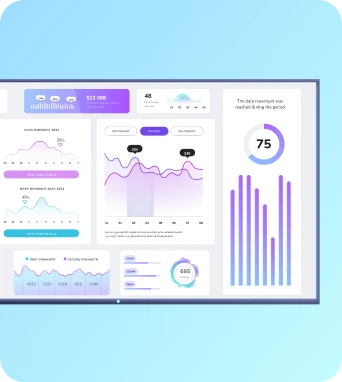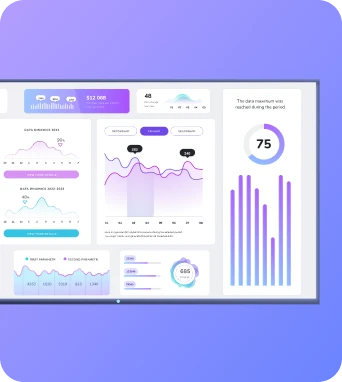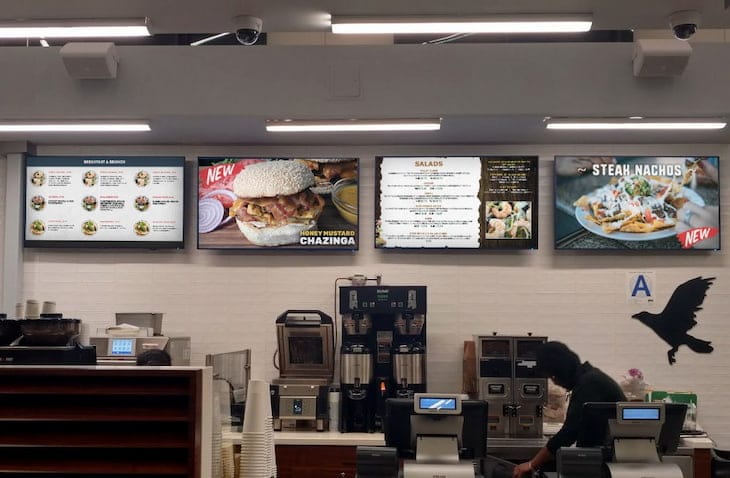There's good menu board software, and then there's great menu board software. The biggest difference between the two? The quality of features you get.
Now, the specific features you'll need from your digital menu board solution depend on your industry, menu content, and customers. But if the software you choose doesn't offer the basics, it will be a lot harder to scale over time.
This guide explains everything you should know about digital menu board software — including its must-have features — so you can choose the perfect platform. We also explain why you need them for your business so you can stay ahead of the curve with delightful digital menus.
But first: why even bother with digital menu boards?

There’s nothing necessarily wrong with choosing physical menu boards. Maybe they're a better fit for your small-but-growing business.
But if you're trying to grow bigger (or if you're scaling up quickly), digital menu displays just make more sense.
For example:
- Digital menus are visible from longer distances. If there's a long line to your register, a digital menu board can help customers pick a meal even from the back of the line.
- You can update digital menu items at the drop of a hat. Traditional menus require a lot more effort — you'd better have patience, a new marker, and great handwriting.
- Digital signage can make you more money. Studies show implementing a single screen into your business can have a 3% to 5% uplift on total sales.
- Digital signage keeps guests happy. They don't just feel like their wait time is going faster, but can whet their appetites and feel more confident about their meal choices.
- Digital menu board templates can help you manage multiple business locations. It’s simple and easy to expand your operations and ensure every menu stays the same between branches.
There's a lot more to be said about the power of digital menus, but in the spirit of brevity, you should check out the four advantages of digital menu boards over static menu boards.
The 10 top features your digital menu boards need
Whether you're on the hunt for your first digital menu board tool or you're sick and tired of your existing menu board software, here are 10 features your platform needs to be flexible, scalable, and cost-effective for your business.
1. Customizable templates

Building a digital menu board from scratch can be overwhelming at best. You're not a graphic designer (and you don't play one on TV), so the thought of creating a good-looking menu board sends shivers down your spine.
The good news is that quality digital signage platforms offer simple boilerplates to help you get started. Best-in-show providers like the team behind Fugo can help you customize a template directly in our content studio.
First, you select a template from our list. Then, you can customize it based on your restaurants' colors, menu items, or location. All you need to do is drag and drop text, and you can build a beautiful array of daily specials directly on our cloud-based platform.
2. Scheduling & day-parting

Your restaurant probably doesn't serve the same menu items all day. Unfortunately, not all digital menu boards make it easy to switch up mealtimes or deploy time-specific content on the right screen at the right time.
That's not the case with a platform like Fugo, which offers the easiest way to deploy content on a schedule. You can easily build set-it-and-forget-it schedules for:
- Automatic day parting (AKA breakfast, lunch, and dinner menus)
- Schedule daily specials or time-based offers that expire on certain dates or times
- New menus or seasonal offers in multiple locations
3. QR codes

From delivery apps to discount codes, QR codes make digital menu signage easy. You can set up contactless menus, offer rewards points to customers, and even link social media channels to keep customers connected.
The best digital menu boards (including Fugo.ai) come with built-in QR code generators so you can build menus from scratch. Think about directing your customers to premium items during peak times, or encouraging them to complete online orders through their phones.
So long as you have the right tools by your side, the sky is virtually the limit
4. Labels for dietary restrictions

Do you offer vegan dishes? What about gluten-free options? A few tweaks to your digital menu board will let you customize this at scale.
The right platform should allow you to engage customers based on specific dietary patterns, such as keto, vegetarian, and gluten-free. You should also be able to call out restrictions for specific customer needs. For example, you could have a slide detailing your sugar-free desserts, dairy-free entrees, or sensory-friendly appetizers.
Speaking of dietary needs. . .
5. Inputs for nutrition facts

A whopping 71% of consumers want to see calorie counts on menu boards. This isn't usually possible with chalk-and-chalkboard menu systems, but it’s quick, easy, and to the point with digital menu boards.
Think about the different ways you can enhance the customer experience. You can add:
- Detailed breakdowns of your most popular items, such as a brag board calling out 'zero added sugar' or 'no preservatives.'
- Scrolling text so you can fit everything you need on one screen.
- Separate slides for individual ingredients, which may be useful for wellness-minded customers (think a juice bar or salad shop).
6. Video support

Who said digital menu boards were static images only? With a modernized content management system, you can create dynamic menu board content that truly brings your food to life.
Even if you're not using video content currently, there may come a time when your business needs moving signage. Investing up-front in a tool that can do this will save you time, money, and effort as you improve operational efficiency.
We don't mean to toot our own horn, but Fugo.ai supports 4k video streaming so you can bring the best to your customers without compromising on quality. It also allows you to improve the customer experience. Because who doesn't want a video of delicious, melty ice cream?!
7. Simple updating mechanisms

Digital menu board software should help you work smarter, not harder. But if you can't easily update your content, it's not much better than the chalkboards of yore.
As many as one in three restaurateurs update their menus every month, while another one in four business owners update their menus with the seasons. Doing this manually will be a massive challenge, and ineffective digital menu boards won’t be a much better option.
Thankfully, platforms like Fugo offer all-in-one solutions for updating menus at scale. We make it easy to:
- Batch edit menu items
- Update pricing
- Add images to different menus
- Swap out or update schedules
- Change information from any computer from anywhere with a WiFi connection
If you're using a digital asset management (DAM) platform like Canto, Fugo makes it easy to connect your media library directly to your digital menu boards. This Canto digital signage app allows you to access, update, and deploy your branded menu content seamlessly across all your screens without the hassle of manual re-uploads.
From high-quality food images to seasonal menu updates, your DAM software can keep your menus fresh and on-brand with minimal effort.
8. Social media feeds

You don't just want customers to love your food: you also want them to fall in love with your branding. You can build up this lifestyle brand with a push toward social media, which you can encourage with a customer incentive, a discount, or a point-based loyalty program.
With Fugo, you can easily integrate social media handles along the bottom of every digital menu board. You can also display social media feeds showcasing positive customer feedback, hashtags, and images.
💡Related: Social Media Wall for Digital Signage
9. Remote device management
So you've closed up your business and headed home for the day — only to be told there's been a recall on frozen chicken. Rather than rushing back over and scratching menu items off your chalkboard, you can pop open your digital signage tool and update your menu from anywhere.
Remote device management tools allow you to keep track of display menus, which let you quick, simple upgrades from wherever you happen to be. It gets even easier with Fugo's software: you can track every screen in your network behind a single pane of glass.
10. Integrates with existing hardware
This is less of a feature than a compatibility setting, but it's still absolutely imperative to purchase menu board software with third-party connectivity.
For example, you should be able to use the tools you're already using, including third-party apps and programs like Dropbox. You should also be able to connect with the hardware you currently own — including your media player and/or Smart TV platform.
Fugo proudly connects to dozens of third-party apps so you can set up digital menu boards however you please. We also support hundreds of media players and consumer-grade TVs, from Sony, IAdea, and Brightsign to the Raspberry Pi 5.
Get started with digital menu boards
Using Fugo.ai as your digital menu board solution is the easiest way to display menu items at scale. You can wow customers with mouthwatering images, add videos, stickers, and nutrition facts, and even set up a QR code for discounts — all using the hardware you already own.
It's not hard to see why thousands of customers have rated Fugo.ai as the best digital menu board software for small and growing businesses.
No need to take our word for it, though.
Sign up for a 14-day free trial to display digital menu board content in 15 minutes or less.





